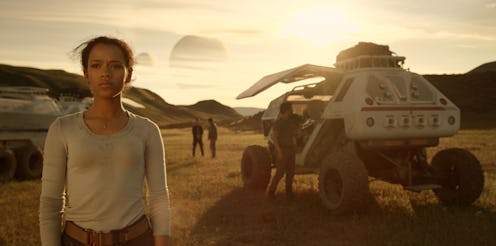
Netflix's reboot of the classic science fiction series Lost In Space premiered on April 13, adapting the '60s source material for modern audiences while incorporating many of the familiar trappings of the original. Just like the '60s series, this version revolves around the Robinson family and their trusty robot companion as they try to survive on an alien planet after a crash landing. But while its history can be traced back over 50 years, there are also clear shades of two popular sci-fi shows from the past decade and a half in Netflix's Lost In Space. The reboot borrows elements from Battlestar Galactica and Lost to turn a campy space adventure into a dramatic tale of survival. Mild spoilers for Episodes 1 and 2.
What the audience learns about the Robinson family in flashback in the first two episodes would be enough to fill an entire season of TV. Formerly an all-American family living a fairly average life, they must evacuate with the rest of Earth after a massive object called the "Christmas Star" strikes the surface and makes the planet steadily less inhabitable. They move onto a massive spaceship, which is itself evacuated when a menacing robot attacks and begins killing passengers. The Robinson family escapes in a smaller vessel but ends up stranded on an alien planet — utterly lost in space.
The core premise of the series borrows heavily from perhaps the most impressive example of an old science fiction series rebooting and redefining itself for a new generation. Battlestar Galactica, which originally aired in the '70s and was revived in 2004, also follows the surviving remnants of humanity as they attempt to outrun vicious robots that seek their destruction. But while Battlestar uses that setup to tell a story about political intrigue and ongoing war games, Lost In Space is focused more on survival and discovery. This separate focus invites comparison to another show that starts with a group becoming marooned in an unfamiliar place.
In Lost, the passengers of Oceanic Flight 815 quickly learn that the mysterious island on which they await rescue is like something out of another world. Their adventure involves polar bears, time travel, and wells of light that are possibly the source of all life, but can also turn people into smoke monsters. Lost is a show that counts on mystery and theorizing to keep the viewer engaged. Lost In Space changes the tone of its original series by presenting some alien phenomena that audiences will want to see explained. It hopes that you'll keep watching in the search of the reveals.
In this new Lost In Space, Parker Posey takes on the role of "Dr. Smith" — in the original, a male character who coopts an identity that isn't his. (The '60s version provided comic relief, while Posey's is more menacing.) Who is she, really? Pretty much half the cast of Lost were lying about their past in one way or another to be accepted, from Ethan Rom to Kate Austen, and the show slowly revealed their truths.
Probably the most familiar aspect of Lost In Space is the robot — and its catchphrase, "Danger, Will Robinson." It used to be evil but is now an ally to the stranded family. And though Lost is lacking in robots, it does feature plenty of characters who have a change of heart and disavow their former selves, from warlord-turned-spiritualist Mr. Eko to conman-turned-leader James "Sawyer" Ford. Lost In Space is more than just Lost, but in space. But a fan of that recent psychological thriller/sci-fi series will notice while watching the newer show that the two share a great deal of similar DNA.
Battlestar Galactica and Lost both redefined the scope of science fiction television for the 21st century, and chances are a Lost In Space reboot wouldn't be happening if it weren't for the legacy of those two shows — in addition to its own. So though this revival wouldn't be possible without the original, its 2018 sensibilities may owe more to modern examples of the of the genre.